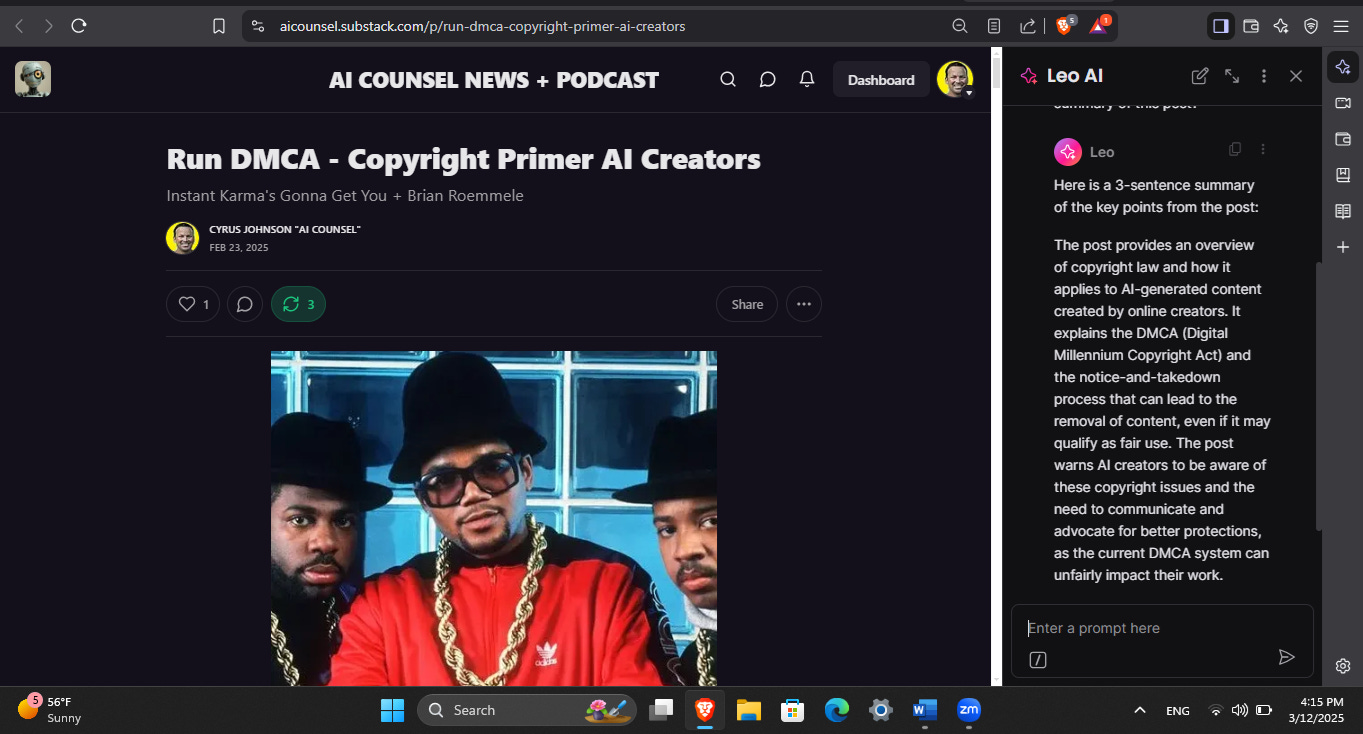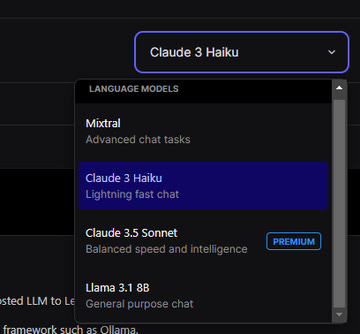If you have not year heard of Brave browser, I’m here to tell you - ESP for AI function.
Use it if you love privacy and AI.
Love it if you want to be able to “cruise” pages with an “AI-eye.”
What do I mean?
Here is an example:
Went to a page from this blog. Clicked on the “Leo” icon, asked for a three sentence summary and bang-o!
»>should also point out that Brave was designed with privacy in mind and pops slowing pop-ups and ads that other browsers allow.
Why the Brave browser is lit and you should consider it : hyper-search with native browser ai expansions.
[Yes, Google and others have an option when you do SEARCH and often you automatically see “AI results” up top. But this is something more. This is a BROWSER (not search) with embedded AI and not just one model but several. And did I say free?]
Native multi-model llm set up right there embedded in Brave.
They recently debuted ‘Leo’ which is their own built-in ai assistant and it affords users the ability to toggle between four (4) different models.
Also Leo is integrated already w Brave search and so will provide enhanced content on search also.
This is what I use.
How I generally have three+ models open at once to be able to source AI content instantly, and Brave gives me a 4x extension of variety on-browser.
My regular “AI Stack” :
Perplexity +
Grok +
Leo assistant to LLM : mixtral/ claude haiku/ claude sonnet/ llama
That’s actually 6 resources!
Be Brave today!
More about Brave :
The Brave browser was created by Brave Software, Inc., a company founded by Brendan Eich and Brian Bondy.
Eich, a notable figure in the tech world, is the co-founder of Mozilla and the creator of JavaScript, while Bondy brought experience from Mozilla and other tech ventures.
The project began in 2015 with a mission to rethink the web browsing experience by prioritizing user privacy, speed, and a fairer digital advertising model.
Initially built on Mozilla’s Gecko engine before switching to Chromium’s Blink engine later that year for better compatibility and performance (with the exception of iOS, where Apple mandates the use of WebKit).
The browser emerged from Eich’s vision to address the growing concerns over online privacy and the inefficiencies of the ad-heavy internet.
After leaving Mozilla in 2014, Eich sought to build a browser that empowered users and creators alike.
Brave gained traction quickly among privacy-conscious users and reached a significant milestone with the release of Brave 1.0 in November 2019, marking its exit from beta status.
By August 2016, Brave Software had secured at least $7 million in angel investments from firms like Peter Thiel’s Founders Fund, Propel Venture Partners, and others, fueling its development.
A key early innovation was the introduction of Brave Payments in 2016, which allowed users to make micropayments to content creators using Bitcoin.
This evolved into the Brave Rewards system in April 2019, leveraging the Basic Attention Token (BAT), a cryptocurrency built on Ethereum, to reward users for viewing privacy-respecting ads and to support creators directly.
Over the years, Brave has continued to grow, surpassing 80 million users by 2023 and consistently rolling out features to enhance privacy and performance.
Key Features of the Brave Browser
Privacy and Security (Brave Shields)
Brave’s flagship feature is its built-in Shields system, which blocks third-party ads, trackers, and malicious scripts by default. Unlike traditional browsers that rely on extensions for ad-blocking, Brave integrates this functionality natively, using algorithms inspired by uBlock Origin and Ghostery. It also employs fingerprint randomization (called "farbling") to make each browsing session appear unique to websites, preventing tracking via browser fingerprinting. Additional privacy tools include HTTPS Everywhere for secure connections, bounce tracking protection (introduced as "debouncing" in October 2021), and the removal of tracking query parameters from URLs.Speed Optimization
By blocking ads and trackers, Brave significantly reduces page load times—often 3x to 6x faster than competitors like Chrome or Firefox. Built on the Chromium engine, it ensures compatibility with modern web standards while optimizing resource use, saving bandwidth, and extending device battery life.Brave Rewards and BAT
Brave introduced a revolutionary advertising model with Brave Rewards. Users can opt into viewing privacy-preserving ads and earn Basic Attention Tokens (BAT), which can be tipped to content creators, redeemed for rewards, or withdrawn to wallets like Gemini or Uphold. This system targets ads locally based on browsing history without sending personal data externally, aiming to create a fairer ecosystem for users and publishers. As of 2021, Brave held 200 million BATs for its ad system and seeded 300 million BATs for user wallets.Tor Integration
Since June 2018, Brave has offered Tor support in its desktop version, accessible via private windows. This allows users to browse anonymously by routing traffic through the Tor network, complete with .onion address support and Tor bridges, enhancing privacy for sensitive activities.Additional Features
Brave Search: Launched as a privacy-focused, independent search engine, it became the default for new Brave users and is available at search.brave.com for other browsers.
Brave Wallet: A native, extension-free crypto wallet supporting Ethereum-compatible chains and NFTs, introduced to streamline Web3 interactions.
Wayback Machine Integration: Since February 2020, Brave automatically queries the Wayback Machine for cached versions of pages when encountering errors like HTTP 404.
Playlist: An iOS feature (expanded to other platforms) for creating offline audio/video playlists directly in the browser.
Sync: Encrypted syncing of bookmarks, passwords, and other data across devices, keeping user information inaccessible to Brave itself.
AI - “LEO”: The first and only browser to include a native AI assistant.








